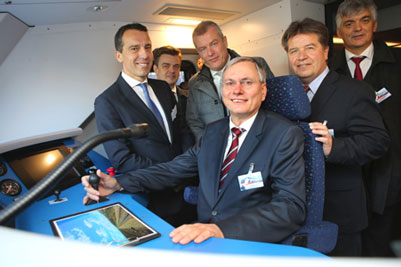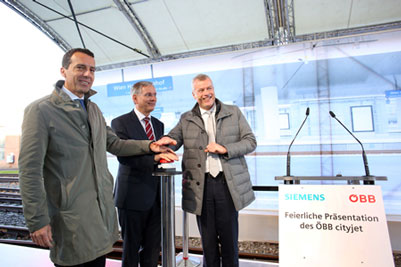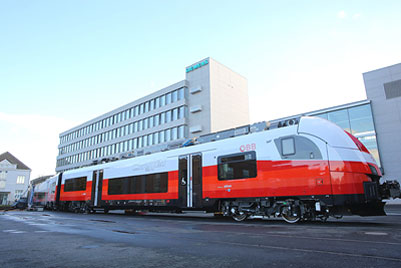ÖBB cityjet Desiro presented
Posted: 11 November 2014 | | No comments yet
The Austrian Federal Minister for Transport, Alois Stöger, and the CEO of Austrian Federal Railways (ÖBB), Christian Kern, were joined by Jochen Eickholt, CEO of the Siemens Mobility Division, in presenting the new Desiro type regional multiple-unit train for Austria at the Siemens plant in Krefeld (Germany)…


l-r: Christian Kern, CEO of ÖBB; Jürgen Wilder, CEO of Siemens Business Unit Mainline Transport; Jochen Eickholt, CEO of the Siemens Mobility Division; the Austrian Federal Minister for Transport, Alois Stöger; Reinhold Entholzer, State Commissioner for Transportation Upper Austria; and Arnulf Wolfram, Head of Mobility Siemens Austria (Image: Siemens)
The Austrian Federal Minister for Transport, Alois Stöger, and the CEO of Austrian Federal Railways (ÖBB), Christian Kern, were joined by Jochen Eickholt, CEO of the Siemens Mobility Division, in presenting the new Desiro type regional multiple-unit train for Austria at the Siemens plant in Krefeld (Germany). The first train is currently undergoing tests at the Test and Validation Center in Wegberg-Wildenrath. Tests in the Rail Tec Arsenal (RTA) climatic wind tunnel in Vienna will start in January 2015. The certification runs will then get underway in March 2015. Commissioning is scheduled for autumn 2015.


l-r: The CEO of Austrian Federal Railways (ÖBB), Christian Kern, and the Austrian Federal Minister for Transport, Alois Stöger, were joined by Jochen Eickholt, CEO of the Siemens Mobility Division, in presenting the new Desiro type regional multiple-unit train for Austria at the Siemens plant in Krefeld (Germany) (Image: Siemens)
In spring 2013, ÖBB ordered new trains for local and regional services based on an EU-wide call for tenders. With these, ÖBB will further modernize its vehicle fleet. Final production of around two-thirds of the trains will be performed in the ÖBB workshops in Austria, as previously for the railjets and the Taurus locomotives. The bogies will be supplied by the Siemens plant in Graz. 31 trains are earmarked for commuter rail services in Vienna and Lower Austria, while 35 are to be used in Lower Austria, 18 in Styria and 17 in Upper Austria in regional rail service.


The ÖBB cityjet is a three-car electric multiple unit, which, in the commuter version, has more than 244 seats and, in the regional version, more than 259 seats per train (Image: Siemens)
The ÖBB cityjet is a three-car electric multiple unit, which, in the commuter version, has more than 244 seats and, in the regional version, more than 259 seats per train. Convenient low-floor entrances guarantee barrier-free access without ramps, even for wheelchair users and families with strollers or baby carriages. The major focus is on sitting comfort: passengers relax in comfortable, adjustable seats with armrests and foot supports, LED lighting adjusted to the seating position, and passenger information on screens in the interior of the cars. In addition, power sockets, tables, and window roller blinds are planned. The commuter trains have six doors on each side; the regional trains, four. The ÖBB cityjet reaches a maximum speed of 160 km/h.
The mileage covered between maintenance intervals can be up to three times greater than for existing vehicles. The ÖBB cityjet will be licensed to operate on all routes in Austria without restriction. It has been technically adapted to permit encounters with mainline trains traveling at 250 km/h without any problem.


l-r: Christian Kern, CEO of ÖBB; Jürgen Wilder, CEO of Siemens Business Unit Mainline Transport; Jochen Eickholt, CEO of the Siemens Mobility Division; the Austrian Federal Minister for Transport, Alois Stöger; Reinhold Entholzer, State Commissioner for Transportation Upper Austria; and Arnulf Wolfram, Head of Mobility Siemens Austria (Image: Siemens)
High efficiency of the traction system, electrodynamic regenerative braking with energy feedback, use of heat dissipated from the traction system to heat the passenger compartments, and oil-free compressors ensure efficient and low-resource railroad operations. The vehicle is additionally equipped in the interior and exterior with energy-efficient LED lamps, a low-noise preheating system protects nearby residences when the stabled train is preheated for the passengers during the night. CO2 sensors detect the occupancy level of the vehicle and ensure environmentally friendly control of the redundant air-conditioning system without impairing passenger comfort. The drivers are supported by technical equipment with saving energy during travel and stabling.


The commuter trains have six doors on each side; the regional trains, four (Image: Siemens)
ÖBB will take delivery of up to five trains per month as from December 2015 and put them into service. The last train ordered so far will go to ÖBB in January 2018. All trains will receive unrestricted licensing for Germany and comply with the latest European Technical Specifications for Interoperability (TSI).



